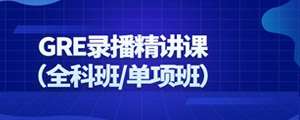选课中心
7099人选课
GMAT公开讲座
0元
GRE公开讲座
0元
一对一体验课
99元
GMAT模考网站
10000人
GRE模考网站
GMAT课程
GRE课程
托福辅导课程
【定制】1v1
私人订制
资料下载
考前冲刺

扫码添加助教
免费领取
备考资料大礼包

扫码关注公众号
新东方在线GMAT频道为大家带来GMAT阅读新题:Passage 19 练习题一文,希望对大家GMAT备考有所帮助。更多精彩尽请关注新东方在线GMAT频道!>>点击查看更多GMAT阅读
Passage 19 (19/63)
In contrast to traditional analyses of minority business, the sociological analysis contends that minority business ownership is a group-level phenomenon, in that it is largely dependent upon social-group resources for its development. Specifically, this analysis indicates that support networks play a critical role in starting and maintaining minority business enterprises by providing owners with a range of assistance, from the informal encouragement of family members and friends to dependable sources of labor and clientele from the owner’s ethnic group (ethnic group: n.同种同文化之民族). Such self-help networks, which encourage and support ethnic minority entrepreneurs, consist of “primary” institutions, those closest to the individual in shaping his or her behavior and beliefs. They are characterized by the face-to-face association and cooperation of persons united by ties of mutual concern. They form an intermediate social level between the individual and larger “secondary” institutions based on impersonal relationships. Primary institutions comprising the support network include kinship, peer, and neighborhood or community subgroups.
A major function of self-help networks is financial support. Most scholars agree that minority business owners have depended primarily on family funds and ethnic community resources for investment capital. Personal savings have been accumulated, often through frugal living habits that require sacrifices by the entire family and are thus a product of long-term family financial behavior. Additional loans and gifts from relatives, forthcoming because of group obligation rather than narrow investment calculation, have supplemented personal savings. Individual entrepreneurs do not necessarily rely on their kin because they cannot obtain financial backing from commercial resources. They may actually avoid banks because they assume that commercial institutions either cannot comprehend the special needs of minority enterprise or charge unreasonably high interest rates.
Within the larger ethnic community, rotating credit associations have been used to raise capital. These associations are informal clubs of friends and other trusted members of the ethnic group who make regular contributions to a fund that is given to each contributor in rotation. One author estimates that 40 percent of New York Chinatown firms established during 1900-1950 utilized such associations as their initial source of capital. However, recent immigrants and third or fourth generations of older groups now employ rotating credit associations only occasionally to raise investment funds. Some groups, like Black Americans, found other means of financial support for their entrepreneurial efforts. The first Black-operated banks were created in the late nineteenth century as depositories (depository: n.存放处) for dues (due: n. [复]应付款) collected from fraternal or lodge groups, which themselves had sprung from Black churches. Black banks made limited investments in other Black enterprises. Irish immigrants in American cities organized many building and loan associations to provide capital for home construction and purchase. They, in turn, provided work for many Irish home-building contractor firms. Other ethnic and minority groups followed similar practices in founding ethnic-directed financial institutions.
1. Based on the information in the passage, it would be LEAST likely for which of the following persons to be part of a self-help network?
(A) The entrepreneur’s childhood friend
(B) The entrepreneur’s aunt
(C) The entrepreneur’s religious leader
(D) The entrepreneur’s neighbor(E)
(E) The entrepreneur’s banker
2. Which of the following illustrates the working of a self-help support network, as such networks are described in the passage?
(A) A public high school offers courses in book-keeping and accounting as part of its open-enrollment adult education program.
(B) The local government in a small city sets up a program that helps teen-agers find summer jobs.
(C) A major commercial bank offers low-interest loans to experienced individuals who hope to establish their own businesses.
(D) A neighborhood-based fraternal organization develops a program of on-the-job (on-the-job: adj.在职的) training for its members and their friends.(D)
(E) A community college offers country residents training programs that can lead to certification in a variety of technical trades.
3. Which of the following can be inferred from the passage about rotating credit associations?
(A) They were developed exclusively by Chinese immigrants.
(B) They accounted for a significant portion of the investment capital used by Chinese immigrants in New York in the early twentieth century.
(C) Third-generation members of an immigrant group who started businesses in the 1920’s would have been unlikely to rely on them.
(D) They were frequently joint endeavors by members of two or three different ethnic groups.(B)
(E) Recent immigrants still frequently turn to rotating credit associations instead of banks for investment capital.
4. The passage best supports which of the following statements?
(A) A minority entrepreneur who had no assistance from family members would not be able to start a business.
(B) Self-help networks have been effective in helping entrepreneurs primarily in the last 50 years.
(C) Minority groups have developed a range of alternatives to standard financing of business ventures.
(D) The financial institutions founded by various ethnic groups owe their success to their unique formal organization.(C)
(E) Successful minority-owned businesses succeed primarily because of the personal strengths of their founders.
5. Which of the following best describes the organization of the second paragraph?
(A) An argument is delineated, followed by a counter-argument.
(B) An assertion is made and several examples are provided to illustrate it.
(C) A situation is described and its historical background is then outlined.
(D) An example of a phenomenon is given and is then used as a basis for general conclusions.(B)
(E) A group of parallel incidents is described and the distinctions among the incidents are then clarified.
6. According to the passage, once a minority-owned business is established, self-help networks contribute which of the following to that business?
(A) Information regarding possible expansion of the business into nearby communities
(B) Encouragement of a business climate that is nearly free of direct competition
(C) Opportunities for the business owner to reinvest profits in other minority-owned businesses
(D) Contact with people who are likely to be customers of the new business(D)
(E) Contact with minority entrepreneurs who are members of other ethnic groups
7. It can be inferred from the passage that traditional analyses of minority business would be LEAST likely to do which of the following?
(A) Examine businesses primarily in their social contexts
(B) Focus on current, rather than historical, examples of business enterprises
(C) Stress common experiences of individual entrepreneurs in starting businesses
(D) Focus on the maintenance of businesses, rather than means of starting them(A)
(E) Focus on the role of individual entrepreneurs in starting a business
8. Which of the following can be inferred from the passage about the Irish building and loan associations mentioned in the last paragraph?
(A) They were started by third- or fourth-generation immigrants.
(B) They originated as offshoots of church-related groups.
(C) They frequently helped Irish entrepreneurs to finance business not connected with construction.
(D) They contributed to the employment of many Irish construction workers.(D)
(E) They provided assistance for construction businesses owned by members of other ethnic groups.
以上就是新东方在线GMAT频道为你带来的GMAT阅读新题练习题,更多精彩敬请关注新东方在线GMAT频道。
| GMAT直播VIP小班 | GMAT直播精讲班 | GMAT录播课 |
| (VIP小班/全科班+1对1) | (全科精讲/单项备考) | (全科班/单项班) |
| 72.5课时 ¥18800 | 61课时 ¥7796 | 134课时 ¥14680 |

 资料下载
资料下载
新东方GMAT佛脚词汇1.0版本
发布时间:2023-06-30添加新东方美研助教号
回复【资料】获取
新东方GMAT数学500题资料下载
发布时间:2023-05-26添加新东方美研助教号
回复【资料】获取
新东方GMAT800题资料下载
发布时间:2022-05-21添加新东方美研助教号
回复【资料】获取
1000句GMAT真实句子改错问题
发布时间:2022-04-17添加新东方美研助教号
回复【资料】获取
2024杨鹏阅读难句(GMAT+GRE)教程
发布时间:2022-04-17添加新东方美研助教号
回复【资料】获取
新东方GMAT数学500题(解析及答案)
发布时间:2019-11-27添加新东方美研助教号
回复【资料】获取
新东方GMAT800题(逻辑+语法+阅读)
发布时间:2019-11-27添加新东方美研助教号
回复【资料】获取
新东方GMAT佛脚词汇1.0版本
发布时间:2019-11-27添加新东方美研助教号
回复【资料】获取
GMAT词汇/长难句/语法资料大全
发布时间:2019-11-27添加新东方美研助教号
回复【资料】获取
GMAT语文考试圣经(Bible)电子版
发布时间:2019-11-27关注新东方在线美研订阅号
回复【GMAT】获取
GMAT推理圣经PDF电子版
发布时间:2019-11-27添加新东方美研助教号
回复【资料】获取
GMAT考试OG五个版本题号对照表
发布时间:2019-11-27添加新东方美研助教号
回复【资料】获取
GMAT Ultimate Grammar电子书籍PDF
发布时间:2019-11-27添加新东方美研助教号
回复【资料】获取

添加美研助教号,
回复【GMAT】获取备考必看资料包

 推荐阅读
推荐阅读
新东方在线GMAT频道为大家带来GMAT阅读复习的五大步骤,希望对大家GMAT备考有所帮助。更多精彩尽请关注新东方在线GMAT频道! 1:原来
新东方在线GMAT频道为大家带来GMAT阅读背景的培养,希望对大家GMAT备考有所帮助。更多精彩尽请关注新东方在线GMAT频道! 一、经济学
新东方在线GMAT频道为大家带来GMAT阅读复习效率不高怎么办,希望对大家GMAT备考有所帮助。更多精彩尽请关注新东方在线GMAT频道! 建
新东方在线GMAT频道为大家带来GMAT阅读提高速度的根本方法,希望对大家GMAT备考有所帮助。更多精彩尽请关注新东方在线GMAT频道! 1
新东方在线GMAT频道为大家带来GMAT阅读如何避免错误,希望对大家GMAT备考有所帮助。更多精彩尽请关注新东方在线GMAT频道! 要避免GMA
新东方在线GMAT频道为大家带来GMAT阅读技巧的提升,希望对大家GMAT备考有所帮助。更多精彩尽请关注新东方在线GMAT频道! GMAT阅读推
新东方在线GMAT频道为大家带来GMAT阅读备考的注意事项,希望对大家GMAT备考有所帮助。更多精彩尽请关注新东方在线GMAT频道! GMAT阅
新东方在线GMAT频道为大家带来GMAT阅读怎么提高自己的能力,希望对大家GMAT备考有所帮助。更多精彩尽请关注新东方在线GMAT频道! 建
新东方在线GMAT频道为大家带来GMAT阅读长句子的备考,希望对大家GMAT备考有所帮助。更多精彩尽请关注新东方在线GMAT频道! 1 首先
新东方在线GMAT频道为大家带来GMAT阅读水平怎么提高,希望对大家GMAT备考有所帮助。更多精彩尽请关注新东方在线GMAT频道! 下面就来


 GRE录播课(全科班/单项班)
GRE录播课(全科班/单项班)
 GMAT6-8人直播VIP小班
GMAT6-8人直播VIP小班
 托福直播精讲班(30天/60天)
托福直播精讲班(30天/60天)
 资料下载
资料下载
添加新东方美研助教号
回复【资料】获取
添加新东方美研助教号
回复【资料】获取
添加新东方美研助教号
回复【资料】获取
添加新东方美研助教号
回复【资料】获取
添加新东方美研助教号
回复【资料】获取
添加新东方美研助教号
回复【资料】获取
添加新东方美研助教号
回复【资料】获取
添加新东方美研助教号
回复【资料】获取
添加新东方美研助教号
回复【资料】获取
关注新东方在线美研订阅号
回复【GMAT】获取
添加新东方美研助教号
回复【资料】获取
添加新东方美研助教号
回复【资料】获取
添加新东方美研助教号
回复【资料】获取

 阅读排行榜
阅读排行榜
 相关内容
相关内容